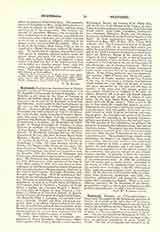

Guatemala, SANTIAGO DE, Archdiocese of (SANCTI JACOBI MAJORIS DE GUATEMALA), conterminous with the Republic of Guatemala, in Central America. It is bounded on the north by the State of Yucatan in Mexico, the British colony of Belize, and the Gulf of Honduras; on the east by the Republics of Honduras and Salvador; on the south by the Pacific Ocean; on the west by the States of Chiapas and Tabasco in Mexico. Its area is 28,950 square miles. Santiago de Guatemala was made a diocese by Paul III December 18, 1534, its first bishop being Don Francisco Marroquin, who came from Spain with the adelantado, or governor, Don Pedro de Alvarado. The episcopal line of succession is as follows: (2) Bernardino de Villalpando, (3) Gomez Fernandez de Cordova, (4) Juan Ramirez de Arellano, (5) Juan Cabezas Altamirano, (6) Juan Zapata y Sandoval, (7) Agustin de Ugarte y Saravia, (8) Bartolome Gonzalez Soltero, (9) Payo Enriquez de Rivera, (10) Juan de Santo Matia Saenz Manozca y Murillo, (11) Juan de Ortega y Montanez, (12) Andres de las Navas y Quevedo, (13) Mauro de Larreategui y Colon, (14) Juan Bautista Alvarez de Toledo, (15) Nicolas Carlos Gomez de Cervantes, (16) Juan Gomez de Parada. On December 16, 1743, the Diocese of Guatemala was raised to metropolitan rank by Benedict XIV, the Dioceses of Nicaragua and Comayagua (Honduras) being assigned to it as suffragans. The Diocese of San Salvador, erected by Gregory XVI, September 28, 1842, and that of San Jose de Costa Rica, erected in 1850, were also added to these suffragans, so that the metropolitan church of Santiago de Guatemala has four suffragan dioceses, which are, in the order of their erection: Nicaragua, Honduras, San Salvador, and San Jose de Costa Rica. With the archdiocese, they constitute the ecclesiastical Province of Central America. The series of archbishops since the erection of the archdiocese, in 1743, is (I) Pedro Pardo de Figueroa, (2) Francisco Jose de Figueredo y Victoria, (3) Pedro Cortez y Larraz, (4) Cayetano Francos y Monroy, (5) Juan Felix de Villegas, (6) Luis Penalver y Cardenas, (7) Rafael de la Vara de la Madrid, (8) Ramon Casaus y Torres, (9) Francisco de Paula Garcia Pelaez, (10) Bernardo Pinol y Aycinena, (11) Ricardo Casanova y Estrada. Church and State being now separated, there is no official relation between the two. By the twenty-fourth article of the Constitution of the Republic, the free exercise of all forms of religion, with no preeminence for any one form, is guaranteed, but only within their respective places of worship.
Formerly, there existed in this archdiocese communities of Friars Preachers (Dominicans), Minor Observantines of St, Francis, Recollect and Capuchin Missionaries, Jesuits, the Oratory of St. Philip Neri, and the Priests of the Mission of St. Vincent de Paul. There were also religious communities of the following female orders: Poor Clares, Capuchins, Conceptionists, Catarinas, Belemites, Rosas, and Dominicans, besides the Religious of the Institute of Sisters of Our Lady. All these communities were suppressed by decrees of May 24, 1872; May 27, 1872; June 7, 1872; March 3, 1874. The Fundamental Law of the Republic, enacted in 1879, by its twenty-fifth article prohibits the establishment of conventual congregations and of any kind of monastic institution or association. There are, however, Sisters of the Institute of St. Vincent de Paul engaged in the service of hospitals and the teaching of poor children; these Sisters are employed in the hospitals of the city of Guatemala, of Quezaltenango, and of Antigua Guatemala. There is but one ecclesiastical college, the Colegio de Infantes, for the choir- and altar-boys of the cathedral. It has fifteen professors and two inspectors, and numbers (1908) 47 intern and 102 extern pupils. The Sisters of Charity conduct in the Casa Central of the city of Guatemala a teaching establishment which, during the year 1908, had 98 girls as interns and gave instruction to 750 girls and 160 boys as externs; in the same year the orphan asylum at the capital, conducted by religious of the same institute, sheltered 190 male and 112 female orphans of more advanced age, besides 35 infants of both sexes. In the Asilo Santa Maria these Sisters had under their care 90 girl interns. There is also in the city of Guatemala the Colegio San Agustin, an establishment for the education of older boys, conducted by a secular priest, with 329 pupils; in the city are nine girls’ schools in which religious instruction and training are given. By the eighteenth article of the Fundamental Law, the teaching in the national institutes, colleges, and schools is entirely secular and gratuitous. The 101 parishes of the archdiocese are grouped, for purposes of ecclesiastical administration, into sixteen vicariates forain. The capital contains four parishes, each served by a parish priest (cura) and an assistant (vicario); there are also 19 churches in the city under a presbitero rector. The cathedral clergy consists of the archbishop, the chapter (six dignitaries: dean, archdean, cantor, schoolmaster, treasurer, and magistral), a priest sacristan in chief, a priest master of ceremonies, six choir chaplains, and a sub-cantor. The administrative organization of the diocese consists of the archbishop, vicar-general, and private and administrative secretary; in addition to these the treasurer-general and two ecclesiastical registrars are members of the ecclesiastical curia. In 1908 the archdiocese had 120 secular and 12 regular priests. According to the census of 1902, the denominational statistics of the republic were: Catholics, 1,422,933; Protestants, 2254; professing other religions, 1146; of no religion, 5113. By the decree of November 15, 1879, the cemeteries were absolutely secularized, and their construction, administration, and inspection subjected exclusively to municipal authority. There is an archdiocesan seminary for the formation of the clergy, governed by a rector, a vice-rector, a chaplain, several prefects and professors; in 1908 it had 16 students.
JOSE MA RAMIREZ COLOM

